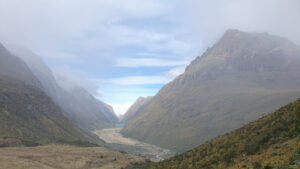Abstract/Description
Protection forests in the European Alps are frequently overaged and lack sufficient advanced regeneration. Accelerating disturbance regimes, particularly on steep, sun-exposed slopes with shallow soils, cause challenging conditions for the restoration of forest functions. In the present study we analyse the performance of artificially regenerated trees at four disturbed sites in the mixed spruce-beech-fir vegetation belt of the Northern Calcareous Alps over 14 years. We established the experiment with pioneering and late successional species. We excluded the effect of ungulate herbivory via fencing. Overall, soil and microsite conditions as well as competition/facilitation by grass, shrubs and herbs explain only a minor proportion of the variance of survival time (r²=0.03 to 0,17; Picea abies < Fagus sylvatica < Abies alba <Larix decidua < Pinus sylvestris < Sorbus aucuparia < S. aria < Alnus incana < Acer pseudoplatanus). Biotic and abiotic factors caused severe mortality already in the first year after planting. Delayed planting at a site already covered by ground vegetation leads to overall higher survival compared to immediate planting after disturbance. There is a species-specific substrate effect on survival and growth. After 14 years, average height of the surviving trees is lowest on dolomite (1.1 m) and does not differ significantly between sites on limestone (2.6 to 3.0 m). Larix is partly outgrowing the resources – a prolonged drought period in 2018 caused desiccation of several well growing trees. On the other end Abies alba grows slow. Foliar analyses show severe deficiencies of phosphorus at all sites and of potassium, sulfur, manganese and partly nitrogen at Tyrolian sites with a history of intensive forest grazing. The results confirm the complex interaction of biotic and site factors for the performance of regeneration and the limited possibilities of post disturbance establishment of Fagus in drought prone mixed mountain forests. Natural regeneration of Acer, Popolus, Salix, Sorbus, Ulmus, Fraxinus etc. additionally contribute to canopy cover and species diversity, demonstrating the importance of pioneer species in post-disturbance forest regeneration. This work was co-funded by the European Union (INTERREG Bavaria-Austria Projects SicAlp (J00183), StratAlp (J00316) and WINALP 21 (BA0100020).


